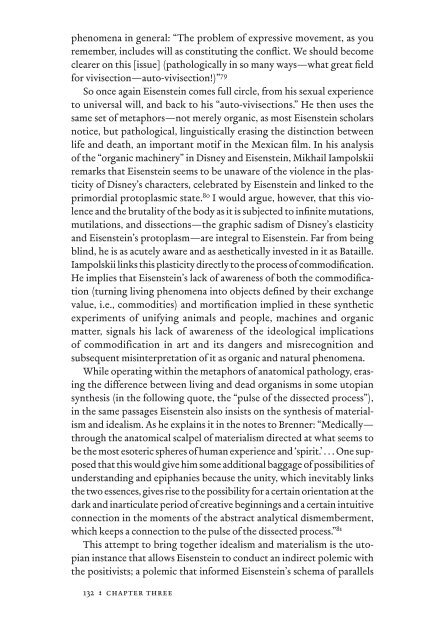In Excess: Sergei Eisentein's Mexico - Cineclub
In Excess: Sergei Eisentein's Mexico - Cineclub
In Excess: Sergei Eisentein's Mexico - Cineclub
Create successful ePaper yourself
Turn your PDF publications into a flip-book with our unique Google optimized e-Paper software.
phenomena in general: “The problem of expressive movement, as you<br />
remember, includes will as constituting the confl ict. We should become<br />
clearer on this [issue] (pathologically in so many ways—what great fi eld<br />
for vivisection—auto-vivisection!)” 79<br />
So once again Eisenstein comes full circle, from his sexual experience<br />
to universal will, and back to his “auto-vivisections.” He then uses the<br />
same set of metaphors—not merely organic, as most Eisenstein scholars<br />
notice, but pathological, linguistically erasing the distinction between<br />
life and death, an important motif in the Mexican fi lm. <strong>In</strong> his analysis<br />
of the “organic machinery” in Disney and Eisenstein, Mikhail Iampolskii<br />
remarks that Eisenstein seems to be unaware of the violence in the plasticity<br />
of Disney’s characters, celebrated by Eisenstein and linked to the<br />
primordial protoplasmic state. 80 I would argue, however, that this violence<br />
and the brutality of the body as it is subjected to infi nite mutations,<br />
mutilations, and dissections—the graphic sadism of Disney’s elasticity<br />
and Eisenstein’s protoplasm—are integral to Eisenstein. Far from being<br />
blind, he is as acutely aware and as aesthetically invested in it as Bataille.<br />
Iampolskii links this plasticity directly to the process of commodifi cation.<br />
He implies that Eisenstein’s lack of awareness of both the commodifi cation<br />
(turning living phenomena into objects defi ned by their exchange<br />
value, i.e., commodities) and mortifi cation implied in these synthetic<br />
experiments of unifying animals and people, machines and organic<br />
matter, signals his lack of awareness of the ideological implications<br />
of commodification in art and its dangers and misrecognition and<br />
subsequent misinterpretation of it as organic and natural phenomena.<br />
While operating within the metaphors of anatomical pathology, erasing<br />
the difference between living and dead organisms in some utopian<br />
synthesis (in the following quote, the “pulse of the dissected process”),<br />
in the same passages Eisenstein also insists on the synthesis of materialism<br />
and idealism. As he explains it in the notes to Brenner: “Medically—<br />
through the anatomical scalpel of materialism directed at what seems to<br />
be the most esoteric spheres of human experience and ‘spirit.’ . . . One supposed<br />
that this would give him some additional baggage of possibilities of<br />
understanding and epiphanies because the unity, which inevitably links<br />
the two essences, gives rise to the possibility for a certain orientation at the<br />
dark and inarticulate period of creative beginnings and a certain intuitive<br />
connection in the moments of the abstract analytical dismemberment,<br />
which keeps a connection to the pulse of the dissected process.” 81<br />
This attempt to bring together idealism and materialism is the utopian<br />
instance that allows Eisenstein to conduct an indirect polemic with<br />
the positivists; a polemic that informed Eisenstein’s schema of parallels<br />
132 : chapter three


